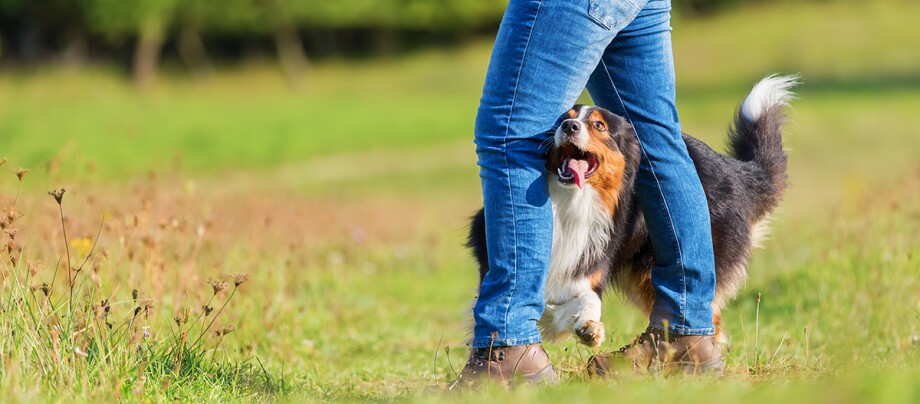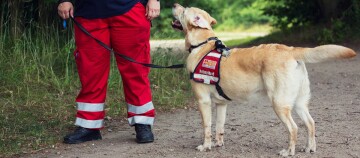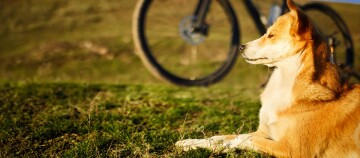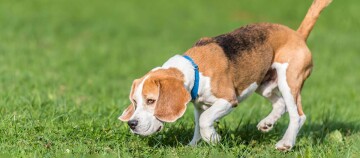Dog Dancing - Hobby That Might Just Be a Thing for Both of You
07.10.2022 - Reading time: 5 minutes

Are you looking for a new challenge? Does your dog like to learn tricks, is it versatile, agile and a good team player? Then dog dancing is just the thing for both of you! Dancing with your dog is not only fun for the dog owner – it is also a dog sport that challenges and encourages the dog in equal measure. Find out here whether this great hobby is also something for you and your dog.
What is dog dancing?
What sounds simple at first is actually a dog sport that comes from demanding obedience training. The British were the first to combine obedience exercises with music – but initially at horse shows. It was in 1990 that Mary Ray presented the first dog exercises performed to music at a dog show.
Since then, dog dancing has become a recognised dog sport that is performed at tournaments. Two types of dog dancing are practised: “heelwork to music” and “freestyle dog dancing”, which is particularly popular in Germany and the USA. While “freestyle dog dancing” allows almost everything in terms of tricks and obedience tasks that can be performed rhythmically to music by the dog-human team, “heelwork to music” is interested in correct footwork and a disciplined programme. This includes 18 different foot positions, which the dog-human team performs in unison to the music and combines with rolls, jumps and turns. Both dog dancing variations demand a great deal of discipline, teamwork and mutual respect between dog owner and dog.
Which dogs can do dog dancing?
Dog dancing is a democratic dog sport in which every dog, large or small, can participate. However, there are three basic requirements that your dog must have in order to get started quickly with the dog dance exercises.
Basic requirements
- Basic obedience with the commands: “sit”, “stay”, “down” and “heel”.
- Recall obedience
- Good social behaviour with humans and other dogs
Your dog should be attentive and curious, but also have a good sense of playfulness. Dog dance is fun for agile dogs who like to work “with their heads”. The beauty of dog dance exercises is that you develop your dog mentally and strengthen its physical coordination skills. The close teamwork also benefits dogs with low self-esteem. And since you determine the dog dance choreography yourself, older dogs and dogs with a handicap who like to move and “think along” are also in good hands here.
What you need to bring: clicker, patience and consistency
Not only must your dog meet certain requirements to enjoy dog dancing, but the same applies for you. Your prerequisites for success are consistency, time and patience as well as the willingness to respond positively to your dog.
The clicker, which has proven itself in many dog sports, is almost indispensable for dog dance exercises.
Dog dancing for beginners: things to bear in mind
Dog dance beginners who are leading inexperienced dogs must first train a few basic exercises and important basic commands such as “sit” and “heel” so that their dog is not overwhelmed by the dog dance exercises.
In addition, you should take the following to heart:
- Your dog should perform flawlessly for about eight out of ten runs before you move on to the next level.
- Never practise for more than 15 minutes at a time.
- Refrain from using body language and gestures as commands so you can be physically unrestricted yourself.
- Practice only with positive reinforcement.
- If an exercise just won’t work, then skip it.
- Always start and fininsh training with a sense of achievement for your dog.
Tips: think of two “markers” to signal the beginning and the end of the exercise session to your dog, for example “It’s starting” and “Finish”. This way your dog knows when it is work and when it is free time. Use short and concise commands and stay consistent. In English or German – it doesn’t matter to your dog.
Dog dance exercises for beginners: it has to be right!
These simple exercises are the essence of dog dancing, because they make it easier for you to move on to more demanding tasks later on.
Command: watch Send your dog to the heel position and put a treat in your hand. Place the closed hand in front of its chin and give the command “watch”. Click as soon as your dog has made eye contact with you. Reward it – but not with the treat from the closed hand.
Command: touch The dog should touch the palm of your hand with its muzzle. Send your dog to your side and hold out the palm of your hand at nose level. It will certainly touch it, thinking there is a treat there. Now click and reward it. If your dog does not automatically touch your palm, try a treat “hidden” in the crook of your thumb. This should only be an initial lure. Only the touch of the (empty) palm is rewarded. Gradually increase the distance between the dog and the palm and alternate hands.
Command: slalom The “slalom” command means that the dog passes between your legs while walking. The task builds on the hand target (see above). Let your dog come to your left side and step forward with your right leg. Now hold your right hand between your legs from behind. The dog should then want to touch the palm of your hand with its muzzle and so automatically passes between your legs. Click at this moment and give the command “slalom”. If the dog is now standing on your right side, repeat the exercise with the left leg.


